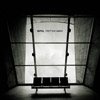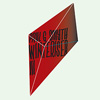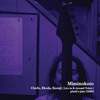
Two new shows just for you.
We have squeezed out two extended release episodes for this weekend to get you through this week. They contain mostly new songs but there's also new issues from the vaults.
The first show features music from Rider/Horse, Mint Field, Robert Aiki Aubrey Lowe, Anastasia Coope, ISAN, Stone Music, La Securite, Bark Psychosis, Jon Rose, Master Wilburn Burchette, Umberto, Wand, Tim Koh, Sun An, and Memory Drawings.
The second episode has music by Laibach, Melt-Banana, Chuck Johnson, X, K. Yoshimatsu, Dorothy Carter, Pavel Milyakov, Violence Gratuite, Mark Templeton, Dummy, Endon, body / negative, Midwife, Alberto Boccardi, Divine.
Cow in Maui from Veronika in Vienna.
Get involved: subscribe, review, rate, share with your friends, send images!
















 Back before he joined Sonic Youth and became an avant rock elder statesman, Jim O'Rourke played in Illusion of Safety with Dan Burke, who has continued the project since his then-partner went all big time. Here, one of those mid-period releases is reissued and remastered, bringing the 18 year old release on Staalplaat back into the economy, and demonstrating how both artists were on the top of their game compositionally even back then.
Back before he joined Sonic Youth and became an avant rock elder statesman, Jim O'Rourke played in Illusion of Safety with Dan Burke, who has continued the project since his then-partner went all big time. Here, one of those mid-period releases is reissued and remastered, bringing the 18 year old release on Staalplaat back into the economy, and demonstrating how both artists were on the top of their game compositionally even back then. The debut release from this American noise duo is a pedestrian attempt at creating som unpleasant, hateful and gripping post-industrial noise. However, Thor J. and Waddiah Rabiah Chami never feel like they are connecting with the sound they are generating. It is a shame because Chami's other work as Koufar prepared me for something huge and powerful which Disgust never manages to pull off. This is noise at its most inoffensive despite the supposed intentions of Disgust.
The debut release from this American noise duo is a pedestrian attempt at creating som unpleasant, hateful and gripping post-industrial noise. However, Thor J. and Waddiah Rabiah Chami never feel like they are connecting with the sound they are generating. It is a shame because Chami's other work as Koufar prepared me for something huge and powerful which Disgust never manages to pull off. This is noise at its most inoffensive despite the supposed intentions of Disgust. On his latest tape, Anthony Mangicapra again explores the sounds and textures of metals in order to find their hidden beauty. Carefully layered and manipulated, the source materials are transformed into a higher form; divinity wrenched from cold, hard matter. This is a vastly different beast to his other recently cassette Ship of the Desert; this is sound both liberated and liberating from reality.
On his latest tape, Anthony Mangicapra again explores the sounds and textures of metals in order to find their hidden beauty. Carefully layered and manipulated, the source materials are transformed into a higher form; divinity wrenched from cold, hard matter. This is a vastly different beast to his other recently cassette Ship of the Desert; this is sound both liberated and liberating from reality. This limited edition collection of live recordings sees irr. app. (ext.) stripped down from its usual group configuration for the stage; for these performances Matthew Waldron braved audiences on his own. The end result is a collection of pieces which allow Waldron to extend the live sound of irr. app. (ext.) into new musical plains. There is less clutter in the arrangements, having one pair of hands forces the music to be sparser than before. Yet the core values at the heart of Waldron’s music are preserved and although his audio surrealism has a new face, it still has the same primal capacity to unnerve and enrapture in equal measure.
This limited edition collection of live recordings sees irr. app. (ext.) stripped down from its usual group configuration for the stage; for these performances Matthew Waldron braved audiences on his own. The end result is a collection of pieces which allow Waldron to extend the live sound of irr. app. (ext.) into new musical plains. There is less clutter in the arrangements, having one pair of hands forces the music to be sparser than before. Yet the core values at the heart of Waldron’s music are preserved and although his audio surrealism has a new face, it still has the same primal capacity to unnerve and enrapture in equal measure. I am a sucker for loud, heavy and white hot rock bands and Mugstar hit home on all three scores. From the opening track to the tinnitus after the CD has stopped playing, I am enthralled by their latest album. Mugstar tear the arse out of my stereo with their pounding performance, every piece on this, their second proper full length, is a mini-masterpiece.
I am a sucker for loud, heavy and white hot rock bands and Mugstar hit home on all three scores. From the opening track to the tinnitus after the CD has stopped playing, I am enthralled by their latest album. Mugstar tear the arse out of my stereo with their pounding performance, every piece on this, their second proper full length, is a mini-masterpiece. Recorded live last year in Dublin, the performance captured here on Paul G. Smyth’s latest album sees him pare back his piano improvisations to a crystalline and cool minimum. Limiting his runs across the keys has resulted in a rich but focussed exploration of the tonal capabilities of the piano (which despite its abundance in recorded music never fails to be a constant source of creative inspiration). Smyth is always a pleasure to listen to and this disc is no exception, I am kicking myself for not having made it to the concert in the first place.
Recorded live last year in Dublin, the performance captured here on Paul G. Smyth’s latest album sees him pare back his piano improvisations to a crystalline and cool minimum. Limiting his runs across the keys has resulted in a rich but focussed exploration of the tonal capabilities of the piano (which despite its abundance in recorded music never fails to be a constant source of creative inspiration). Smyth is always a pleasure to listen to and this disc is no exception, I am kicking myself for not having made it to the concert in the first place. I couldn’t help but feel a twinge of glorious nostalgia when I heard of this project. Justin Broadrick on guitar, Bill Laswell on bass, and Dr. Israel on vocals immediately brought me back to circa 1996-1998, where nearly every non-noise album I picked up had Laswell involved in some way, and I was pretty heavy into the Wordsound catalog at the time. Also, once I realized there was a distinct drum ‘n bass presence here via Submerged and Enduser, I was hoping for something great, but fearing something too rooted in the past. Luckily, my opinion is the former.
I couldn’t help but feel a twinge of glorious nostalgia when I heard of this project. Justin Broadrick on guitar, Bill Laswell on bass, and Dr. Israel on vocals immediately brought me back to circa 1996-1998, where nearly every non-noise album I picked up had Laswell involved in some way, and I was pretty heavy into the Wordsound catalog at the time. Also, once I realized there was a distinct drum ‘n bass presence here via Submerged and Enduser, I was hoping for something great, but fearing something too rooted in the past. Luckily, my opinion is the former. On their first release, this international trio (hailing from the US, UK and Switzerland) approach the world of electronic improvisation from an organic and synthetic perspective, with home made electronic instruments played live and then resampled in real time, where one artists output becomes another’s raw material. The trio of Django Voris, Moritz Wettstein, and PJ Normal do approach the world of krautrock with a different strategy than most, and the results are both dizzying and compelling.
On their first release, this international trio (hailing from the US, UK and Switzerland) approach the world of electronic improvisation from an organic and synthetic perspective, with home made electronic instruments played live and then resampled in real time, where one artists output becomes another’s raw material. The trio of Django Voris, Moritz Wettstein, and PJ Normal do approach the world of krautrock with a different strategy than most, and the results are both dizzying and compelling. As some part of the Acid Mothers Temple nexus of forward thinking rock musicians in Japan, Junzo Suzuki’s Miminokoto keeps the psychedelic freakout tendencies in check, but the trio isn’t afraid to push their folksy sound into rawer, less conventional territory. Compared to his recent Pieces for Hidden Circles, the full band setting helps to create a more diverse and rich tapestry of sound that bears his mark.
As some part of the Acid Mothers Temple nexus of forward thinking rock musicians in Japan, Junzo Suzuki’s Miminokoto keeps the psychedelic freakout tendencies in check, but the trio isn’t afraid to push their folksy sound into rawer, less conventional territory. Compared to his recent Pieces for Hidden Circles, the full band setting helps to create a more diverse and rich tapestry of sound that bears his mark.
